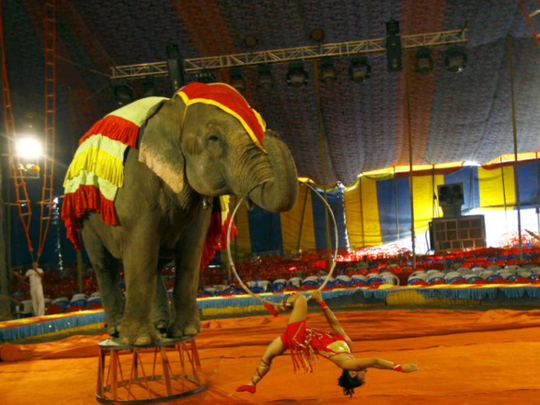
Mumbai: In the early morning heat and dust, daily practice at the Rambo Circus is in full swing. A trapeze creaks as two performers perfect their throws. A Colombian daredevil shouts to his colleagues scrambling atop a giant set of spinning wheels called the Ring of Death.
Looking on with worry is circus manager John Matthew. For 38 years, he has been in the business of entertaining people throughout southern India. But there’s little to smile about these days. The big top set up in a desolate field outside Mumbai seats 3,000 people. Recently, there have been less than 100 tickets sold.
While circuses in other countries struggle to compete with an ever-increasing array of entertainment options, India’s have faced a cataclysm.
In the 1990s, 300 circuses operated throughout the country. That number has dwindled to about 30, says Matthew. And many of those are being hammered by the rising rents for field space, shrinking revenues and - crucially - two Supreme Court rulings that took away the industry’s main attractions.
“After 10 or 15 more years, there may not be any circus at all in India,” Matthew says, sitting at a folding table outside the canvas tent he uses as both office and living quarters.
Circuses once held legendary status in India as entertainment for everyone from princes to pariahs. The biggest names pitched their tents in town centers, drawing huge crowds night after night. The modern circus here is a 130-year-old tradition that according to local lore began when a southern rajah’s horse trainer was taunted by the leader of a visiting Italian show, who said India couldn’t build its own circus. The trainer, Vishnupant Chartre, founded The Great Indian Circus within months, spawning a national love affair with clowns, wild animal acts and death-defying feats.
In the 1990s, India’s Supreme Court banned the use of wild animals in circuses, citing widespread neglect of lions, bears, monkeys and panthers. Then, two years ago, it banned child performers.
“There are instances of sexual abuse on a daily basis, physical abuse as well as emotional abuse. The children are deprived of basic needs of food and water,” the activist group Bachpan Bachao Andolan said in the lawsuit charging exploitation of young children that led to the ban.
Matthew, however, disagrees with both court bans. He remembers fondly his early days in the circus when there was a menagerie of trained tigers, elephants and other exotic animals that were the main draw for audiences.
“We loved our animals, and our business depended on them. So we took good care of them,” he insists. As for child labor, he says, circuses used to give a skill and livelihood to poor children unable to go school.
Biju Nair was once one of those children. At age 10, he literally ran away and joined the circus.
Fleeing an abusive home, he stowed away on a train to Mumbai - then called Bombay - and wandered the streets. Hungry and desperate, he wandered into a circus and was given a plateful of food and a job as a ticket taker. In his teens, he used to sneak into the tent to watch the performance, particularly fascinated by the clown acts. Eventually, he persuaded the clowns to teach him their trade.
Now 42, Nair is the principal clown at Rambo Circus, a job he takes pride in. He says he scours YouTube for videos of international clowning acts to give him new ideas with help from other performers who know how to read and write, since he never learned.
“It’s a hard life in many ways, yes, but it gave me a chance,” he says. “And there is a good feeling in making people laugh.”
Still, he is glad his two children, who live with his late wife’s parents in Kerala, are getting an education in school, instead the circus.
Nair, too, doesn’t see much of a future for circuses in India now that child apprenticeships are banned. Skills like acrobatics and tightrope walking have to be taught young, he says, but there are no students anymore.
“You don’t just wake up at 20 and learn to do these things,” he says.
With a shortage of homegrown performers, Indian circuses have turned to foreign acts. That’s how the three Colombian performers and their Ring of Death come to the Rambo Circus
In the midday lull between practice and the afternoon’s performance, 26-year-old Colombian Jhean Carlos lounges in the plywood cubicle the travelling crew builds for him each time they set up camp. The generator-powered air conditioner signifies his status as the star of the show.
The Colombians mostly keep to themselves, because they speak only Spanish. When the staff really needs to communicate with them, they use a computer translation program.
Carlos says he’s a fourth-generation circus performer, and in his home country, such performers have benefits and insurance against injury and illness. That impresses Nair, who makes just 8,000 rupees ($150) per month with no benefits other than housing in a shared canvas tent. But Nair and most Indian performers say Rambo is one of the better circuses in India.












